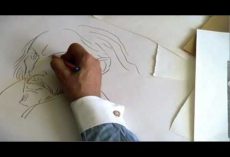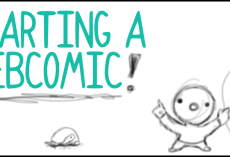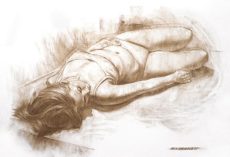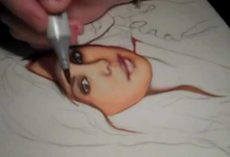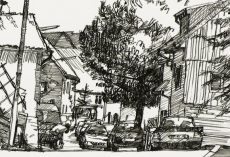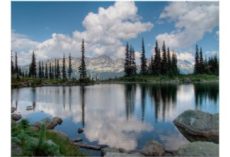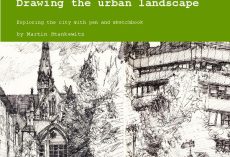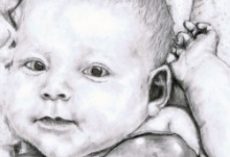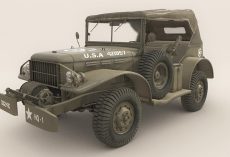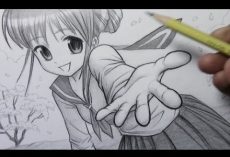How to make fast progress in drawing landscapes (and other things)
After years of drawing, having attended workshops and having studied tutorials and art books I found eight drawing that helped me most to improve my landscape drawing skills efficiently and fast.
Everybody who can write her/his own name on a piece of paper can achieve a high level of drawing skills as writing and drawing require in principle the same capabilities of hand to eye co-ordination. This is a matter of fact. Recently I found another interesting scientific article on the topic which underlines these simple insights: Why Are Some People Better at Drawing than Others?. In the end learning drawing from life is nothing but training,learning and changing your perception of the world as you see it.
If you follow these drawing tips and apply and observe them in regular exercises you will see a dramatic change in your drawing capability in relatively short time of weeks and months.
Doing one drawing exercise of 20-0 minutes a day is already enough. The most important thing is to exercise regularly.
Landscape drawing TIP No.1 – Forget the eraser !
Miles Davis : “Do not fear mistakes, there are none.”
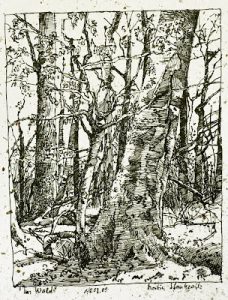
Every line you draw counts and is important. Knowing this will
give your drawings the necessary drive and the motivation to accept your own hand-write. Your own hand-write is the basis for a unique artistic development ! Do you want to erase that ?? Draw with media that cannot be erased as often as possible. My preferred media are ink and pens. The more you exercise the more you will like it. You will gain self-confidence in your lines and marks and you will discover your own drawing style. Your skills to hit the “right” line first will improve fast too.
My top recommendation for Drawing books
When it comes to drawing books Bert Dodson is my favorite. His first book “Keys to drawing” set an unbeaten standard from my point of view.
Landscape drawing TIP No.2 – Blind drawing ..blind drawing….blind drawing
Blind drawing often also called blind contour drawing is a method that occurs in all serious drawing lessons and books.
Blind drawing means that you draw without looking at your drawing paper, but following your subject with your eyes and to make notes of what you see on your paper at the same time. I found it extremely helpful on drawing trees.
Blind drawing is a well known thing in the drawing world, but not many people practise it ! So my advice is don´t forget that, do it and try to remember this each time you start a drawing.
The training effect is absolutely great. Within 2 weeks of 15 minutes of blind drawing per day you can make unbelievable progress! Blind drawing will keep your work vivid.. it is a real ANTI-STIFFENER
Landscape drawing TIP No.3 – Drawing negative forms or space
Imagine you want to draw a net of thick ropes. Drawing negative forms means that you don´t try to draw the outlines of the ropes, but the outlines of the empty space in between the ropes.
Negative forms can be seen almost everywhere. Drawing negative spaces makes things quite often much easier, than following complicated outlines of positive forms. Also drawing negative forms helps quickly to develop stronger observations skills.
Link tipp: DRAWING “NEGATIVE” SPACE
description by Robert Gardiner, the University of British Columbia, Vancouver, Canada
Landscape drawing TIP No.4 – Squinting to see values and simple forms
By squinting with your eyes (remember Dustin Hoffmann
in “Little big man” :).) it is easier to see the different tonalities, the patterns of dark and light forms, the contrast between light and shadows in the scenery in front of you.
Link Tipp:
Squinting, Drawing and Never Forgetting
By R.W. STEVENSON
Published: July 11, 2004
Landscape drawing TIP No.5 – Take measurements !
Handling of the proportions is mostly considered an important issue. “Oh I don´t get the proportions right !” How many times is this said and thought ?
There is a way to eliminate that question. Take measurements and start to train your eye.
Use a little stick or your pencil as reference.
Select an important or clear line in the motif as metrestick. Stretch our your arm as far as you can (in order to get same scale each time) and then measure how long is that roof top for example and how long is that window frame in comparison to that. How tall is the chimney in comparison to your “roof top metrestick” and so on.
As time goes by you won´t need much of measurements anymore. You will get rid of wrong proportions quickly if you decide to use the measurements intensly until you don´t need them anymore.
You will learn quickly to place your drawing in the right size so it fits onto your paper, you will be able to estimate lengths and distances amazingly correct. Fractions like 1:2 ,1:4, 1:3,2:3, etc. will be no problem any more.
Landscape drawing TIP No.6 – Use construction lines
Construction lines are imagined connections between to points in your drawing or an elongation of a line.
If your not sure what the inclination of the roof is for example just elongate the roof edge until it hits another line. Use your pencil or a small stick again to take aim. Thus it is very easy to find a second point in your drawing to confirm the real inclination of lines or planes.
Possible useful constructionlines in this drawing:
If you are not sure about the angle of the church roof just elongate a line (no3) until it hits the vertical no1 almost exactly on the border of the drawing. The elongation of the roof line represented by no.4 hits the church door in the lower right edge of the forth window (left row of windows). Line number 2 connects the balcony of the big building on the right with a prominent edge of a tall building on the left. This way you can develop a grid work that connects the parts of the composition into an image that makes sense to the viewer. Of course it is helpful to understand the theory of perspective, but in practise it is much easier to work with construction lines.
How to draw a tree – a paperback published on BLURB
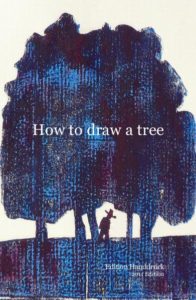
The little book in format 8X5 is based on the content of this lens. It contains
70 black and white images of pen, ink and charcoal drawings. You will find many of the illustrations on this lens, but others also from related lenses on drawing deciduous and coniferous trees and some extra images too in the book.
The book summarizes my experiences in drawing trees. The majority of drawings are deciduous trees, but there is also an explanations about pine tree drwaing and spruce.
Link to the book How to draw a tree There is a full preview available.
Drawing the urban landscape
Exploring the city with a sketchbook
Between April 2006 and May 2007 I have worked on an exhibition project about the urban landscape of the city of Stuttgart,Germany.
I have selected more than 30 drawings for a book now available online at BLURB.
The first 10 pages show panoramic drawings together with the essay about the urban landscape and the experience of drawing such a complex subject. The following pages show two panoramic drawings per page without text.
Drawing TIP No.7 – go into the zoo and get into the flow
With increasing exercise your drawing speed will increase. Also you will find your personal work flow. Most people do not recognize how fast they are drawing when they are in the flow.
To get into the flow while drawing is a wonderful experinece. Everything seems to happen easily without tension just as if you were knitting :).
Drawing moving animals forces you to be fast and almost within minutes most people adjust to the new situation an skip all rational reflections and internal self-dialog and just dive into the visual encounter !
When you come up to the surface again you will feel great ! Drawing a landcape and/ or architecture shortly afterwards is like getting into extrem slow motion and goes much,much easier.
How did I do this drawing:
Everybody who has been watching animals in a zoo knows that animals unfortunate enough to live in cages or aquariums develop an individual moving pattern within the space they can roam.
So instead of trying to draw one fish after the other I worked short sequences on those fish who had taken a specific resting position for a minute or so. When my model moved I looked for the next fish in another resting position. So in fact I always worked on a fish that did NOT move! Some of the fishes are one and the same individual (the big one watched me very interested !)and O.K. the turtle was easy…:).
Drawing TIP No.8 – regular exercise !
If you want to improve your skills repeated exercise is the key. Everybody has his/her own preferences and possibilities to exercise on a regular basis. Similar to sports it is better to practise every day for 15 minutes instead 90 minutes only once a week.
My reading tip : Beginners guide to drawing
Great drawing tip by Michele Weller
The extra tip – 36 pages great sketching advice from 1900
Sketching from nature in line and tone
This is a great find on the net. A fully digitalised version of a book by J. Littlejohns
in the library of the university of San Diego,California. It contains great illustrations and practical advice !
Sketching from Nature
SKETCHING FROM NATURE IN LINE AND TONE
BY J. LITTLEJOHNS, R.B.A., A.R.B.C.
CONTENTS
INTRODUCTION 5,Chapter I. MATERIALS 7,II. HOW TO BEGIN 10,III. DRAWING 16,IV. TREES 19,V. DISTANCE 23,VI. CLOUDS, WATER, AND RE-
FLECTIONS 28,VII. WASH DRAWING 31,VIII. CHALK DRAWING .. ..34
Two awsome stories about people who make their living by drawing
I stumbled into this stories which I can relate to so much. When it come to drawing talent is one thing, but it is not everything. Most people are not prepared to pay the price for aquiring drawing skills: time and practise.
These stories are a great motivation.
Neuland – Dialog: A QUESTION OF WILL MORE THAN TALENT
The story of Jørn Nielsen who was told that he could never make a living out of his drawing skills.
Neuland – Dialog: I do my two favorite things for a living: drawing and thinking.
I do my two favorite things for a living: drawing and thinking.
Interview with Brandy Agerbeck, Chicago

